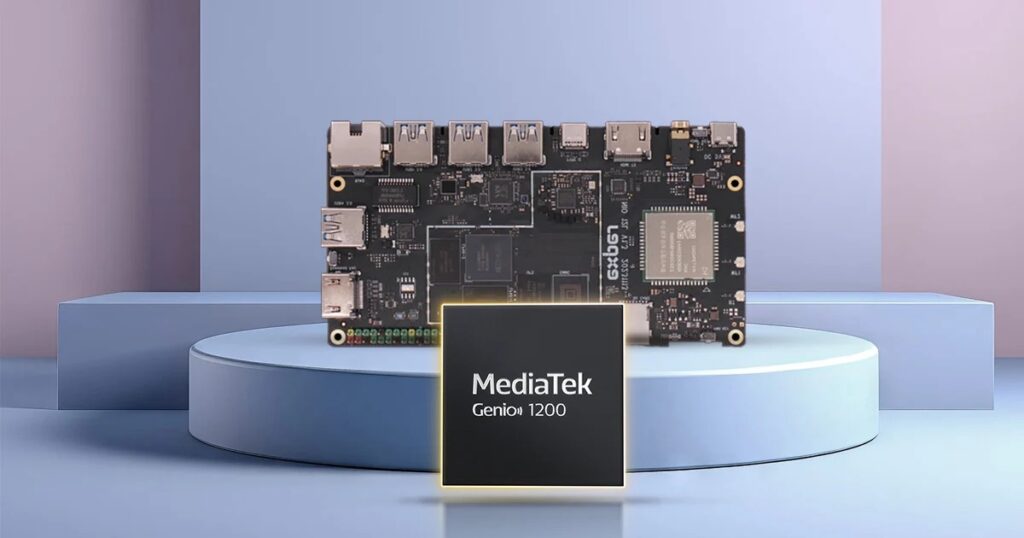The MediaTek Genio 1200 is part of MediaTek’s Genio series of system-on-chips (SoCs), which are designed primarily for smart home devices, AIoT (Artificial Intelligence of Things), and edge computing applications. The Genio 1200 chipset is more oriented toward AIoT and connected devices rather than smartphones, which distinguishes it from MediaTek’s Dimensity and Helio series.
Key Features of the MediaTek Genio 1200:
1. CPU:
• The Genio 1200 is powered by octa-core CPU, likely built on the ARM Cortex-A78 and Cortex-A55 architecture. This provides a high-performance core configuration with a balance of efficiency and power.
• Cortex-A78 cores are designed for high performance, ideal for demanding tasks like gaming, AI, and heavy multitasking.
• Cortex-A55 cores are more power-efficient, intended for lighter, day-to-day tasks.
2. GPU:
• The Genio 1200 likely integrates a Mali-G77 GPU, a high-performance graphics processor used for smooth gaming, media playback, and UI rendering. This GPU is optimized for handling AI-enhanced graphics, supporting richer visual experiences and edge AI processing.
3. AI Capabilities:
• The Genio 1200 integrates MediaTek’s AI Processing Unit (APU), which allows it to perform AI tasks locally on the device, making it well-suited for edge AI applications. This can be used for AI-driven features like voice recognition, image enhancement, smart home automation, and other AI-enhanced applications.
4. Connectivity:
• The Genio 1200 features comprehensive connectivity options, including Wi-Fi 6, Bluetooth 5.2, and 5G support (possibly sub-6 GHz), making it ideal for IoT, smart home, and connected devices. The inclusion of 5G enables fast, low-latency communication, essential for next-gen smart devices.
5. Camera Support:
• It supports high-performance camera processing, capable of handling multi-camera setups, and provides AI-powered imaging enhancements like scene detection and real-time optimizations.
6. Media Support:
• The Genio 1200 can handle 4K video playback and HDR10+, offering a high-quality media experience. This is beneficial for devices like smart displays, smart TVs, and multimedia devices.
7. Manufacturing Process:
• The Genio 1200 is likely built on a 6nm or 7nm manufacturing process, offering energy efficiency and high performance suitable for always-on devices in AIoT ecosystems.
Target Applications for MediaTek Genio 1200:
• AIoT Devices: It’s aimed at AI-powered smart home gadgets, robotics, wearable devices, smart speakers, smart cameras, and other connected devices.
• Edge Computing: Supports on-device processing for applications that require low-latency AI tasks, such as image recognition, voice control, and gesture detection.
• Smart Displays and Hubs: MediaTek Genio 1200 is designed to handle interactive, always-on systems with features like 4K video decoding and multi-camera support, perfect for smart TVs, video conferencing devices, and smart assistants.
Genio 1200 vs. MediaTek Dimensity / Helio:
• While Dimensity SoCs are designed for smartphones, the Genio series targets more specialized use cases such as AIoT, edge AI, and connected devices.
• Dimensity chips are focused on premium smartphone performance, whereas Genio focuses on smart home, IoT, and AI applications in connected devices.
Development and Support:
• For developers, the MediaTek Genio 1200 would likely come with extensive AI SDKs, IoT frameworks, and tools to assist in building smart devices. This is in line with the growing trend of edge AI and IoT integration.
Summary of the Key Specifications:
• CPU: Octa-core (Cortex-A78 + Cortex-A55)
• GPU: Mali-G77
• AI: MediaTek AI Processing Unit (APU)
• Connectivity: Wi-Fi 6, Bluetooth 5.2, 5G (sub-6 GHz)
• Camera: AI-enhanced camera support (multi-camera setups, 4K)
• Manufacturing Process: Likely 6nm/7nm
• Target Devices: AIoT, smart home devices, edge AI applications
If you’re interested in using or developing for devices based on the Genio 1200, understanding its focus on AI, 5G connectivity, and smart devices is crucial. It’s a chip designed for the future of IoT rather than traditional mobile computing.

